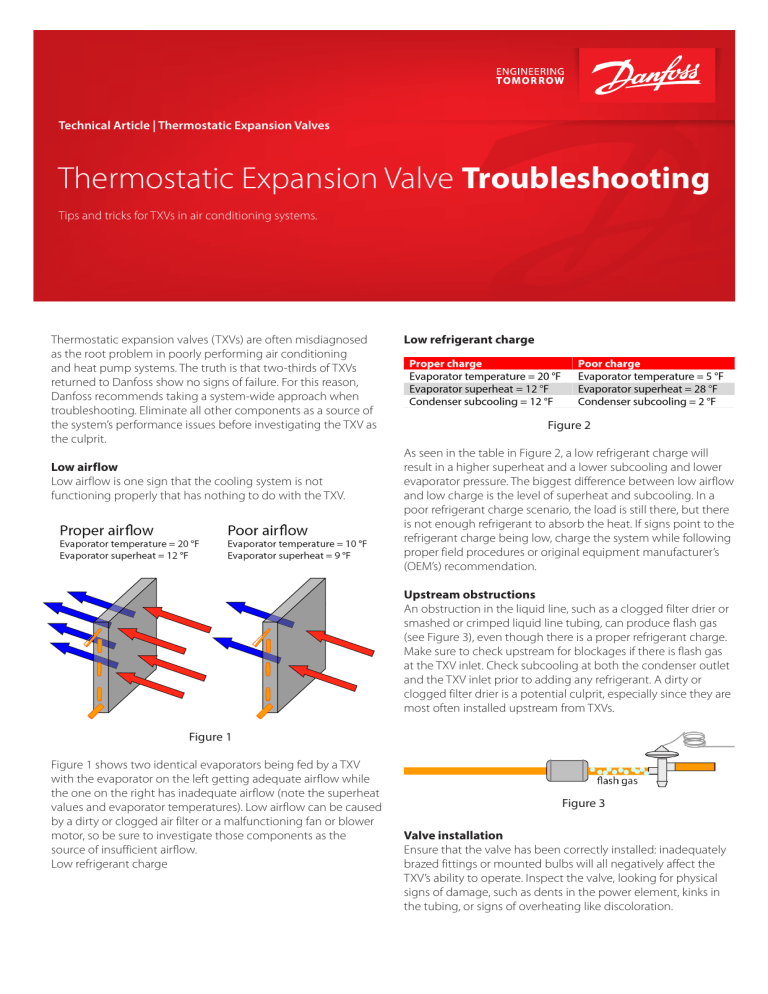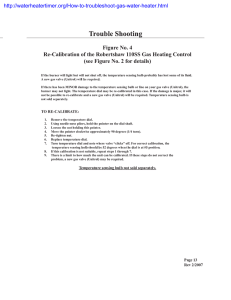Uploaded by
Karthikeyan Visvak
TXV Troubleshooting Guide

Technical Article | Thermostatic Expansion Valves Thermostatic Expansion Valve Troubleshooting Tips and tricks for TXVs in air conditioning systems. Thermostatic expansion valves (TXVs) are often misdiagnosed as the root problem in poorly performing air conditioning and heat pump systems. The truth is that two-thirds of TXVs returned to Danfoss show no signs of failure. For this reason, Danfoss recommends taking a system-wide approach when troubleshooting. Eliminate all other components as a source of the system’s performance issues before investigating the TXV as the culprit. Low airflow Low airflow is one sign that the cooling system is not functioning properly that has nothing to do with the TXV. Low refrigerant charge Figure 2 As seen in the table in Figure 2, a low refrigerant charge will result in a higher superheat and a lower subcooling and lower evaporator pressure. The biggest difference between low airflow and low charge is the level of superheat and subcooling. In a poor refrigerant charge scenario, the load is still there, but there is not enough refrigerant to absorb the heat. If signs point to the refrigerant charge being low, charge the system while following proper field procedures or original equipment manufacturer’s (OEM’s) recommendation. Upstream obstructions An obstruction in the liquid line, such as a clogged filter drier or smashed or crimped liquid line tubing, can produce flash gas (see Figure 3), even though there is a proper refrigerant charge. Make sure to check upstream for blockages if there is flash gas at the TXV inlet. Check subcooling at both the condenser outlet and the TXV inlet prior to adding any refrigerant. A dirty or clogged filter drier is a potential culprit, especially since they are most often installed upstream from TXVs. Figure 1 Figure 1 shows two identical evaporators being fed by a TXV with the evaporator on the left getting adequate airflow while the one on the right has inadequate airflow (note the superheat values and evaporator temperatures). Low airflow can be caused by a dirty or clogged air filter or a malfunctioning fan or blower motor, so be sure to investigate those components as the source of insufficient airflow. Low refrigerant charge Figure 3 Valve installation Ensure that the valve has been correctly installed: inadequately brazed fittings or mounted bulbs will all negatively affect the TXV’s ability to operate. Inspect the valve, looking for physical signs of damage, such as dents in the power element, kinks in the tubing, or signs of overheating like discoloration. Sensing bulb mounting If the bulb mounting is loose, it will cause the TXV to overfeed, possibly flooding the compressor. Since fifty percent of the heat absorbed by the bulb can come from the bulb strap, always use an OEM-recommended bulb strap (as shown in Figure 4). The sensing bulb should be securely mounted on the evaporator outlet downstream from the refrigerant header, in a position on the pipe least affected by liquid refrigerant and oil, and mounted before the equalizer tube. Figure 5 When adjusting the superheat (as seen in Figure 5), verify the rate of change per turn of the superheat spindle for the specific TXV (for example, on Danfoss TR 6 valves, one turn clockwise equals an increase of one degree Fahrenheit). Be sure to note what changes are made to the superheat as it may be necessary to return the valve back to the original setting. Adjust the superheat one or two degrees at a time and give the system ten to fifteen minutes to rebalance. Once the valve is feeding, monitor the superheat as the system goes through a pulldown. Whenever possible, compare the superheat to information provided by the equipment manufacturer. Valve blockage A plugged TXV will underfeed the evaporator and produce symptoms that include the evaporator operating under a vacuum or very low pressures. A plugged valve will not respond to a superheat decrease or will suddenly open up if superheat is adjusted downwards. Some TXVs have an inlet strainer. If the valve has a removable one, it may be removed and cleaned. Figure 4 Overfeeding or underfeeding can also occur if the sensing bulb is not adequately insulated. The bulb should only be sensing the temperature of the evaporator outlet pipe; if it senses ambient temperatures, it will respond according to incorrect conditions. Insulation tape or foam should be liberally applied, ensuring that the sensing bulb is shielded from ambient temperatures. TXV superheat adjustment If these issues cannot be corrected by any other way, adjust the valve’s superheat. Note: adjusting the superheat should only be done after all other corrective measures have been taken. Lost bulb charge Another potential cause for underfeeding is a lost bulb charge. Since the bulb pressure is responsible for driving the valve open, if the pressure is reduced or lost, the evaporator and spring pressures will drive the valve closed. A quick way to check to see if this is the case is to warm the sensing bulb. Simply hold it in your hand for a minute or two (as seen in Figure 6) and if the bulb charge is fine and the valve is not stuck or seized, it should respond by opening. As a reference, use the following checklist to troubleshoot TXVs in the field: Is the airflow low? Is the refrigerant charge or subcooling low? Are there any upstream obstructions? Is the sensing bulb mounted properly? Is the sensing insulated adequately? Are there any signs of valve blockage? Does the sensing bulb respond to heat by opening the valve? Is the superheat correctly set? Is the valve mounted correctly? Is the valve sized according to OEM recommendations? Figure 6 Size of valve A final potential cause for underfeeding is a valve that is too small, which will significantly hinder performance. Check the valve’s rated capacity (highlighted in Figure 7) against the OEM’s recommendations, and the valve capacity should be equal or greater than the OEM’s capacity rating. Danfoss offers training sessions both online and face-toface throughout North America. We also have training materials available for trade schools, community colleges, and other HVACR training program. Visit our website at refrigerationandairconditioning.danfoss.com/support-center/ education-and-training for more information. Figure 7 If, after all other variables have been eliminated and the superheat has been adjusted, the TXV is still not functioning properly, replace it with a new, correctly sized valve. When removing the failed valve, it is important to cut it out rather than sweating it out, as sweating may damage the valve and the manufacturer will not be able to determine the source of the malfunction when it is returned. Danfoss recommends changing the filter drier every time the system is opened as insurance against future problems. Danfoss can accept no responsibility for possible errors in catalogues, brochures, and other printed material. Danfoss reserves the right to alter its products without notice. This also applies to products already on order provided that such alterations can be made without subsequential changes being necessary in specifications already agreed. All trademarks in this material are property of the respective companies. Danfoss and the Danfoss logotype are trademarks of Danfoss A/S. All rights reserved. USCO.EC.000.C1.22 © Copyright Danfoss | Produced by MRB | 2017.12
